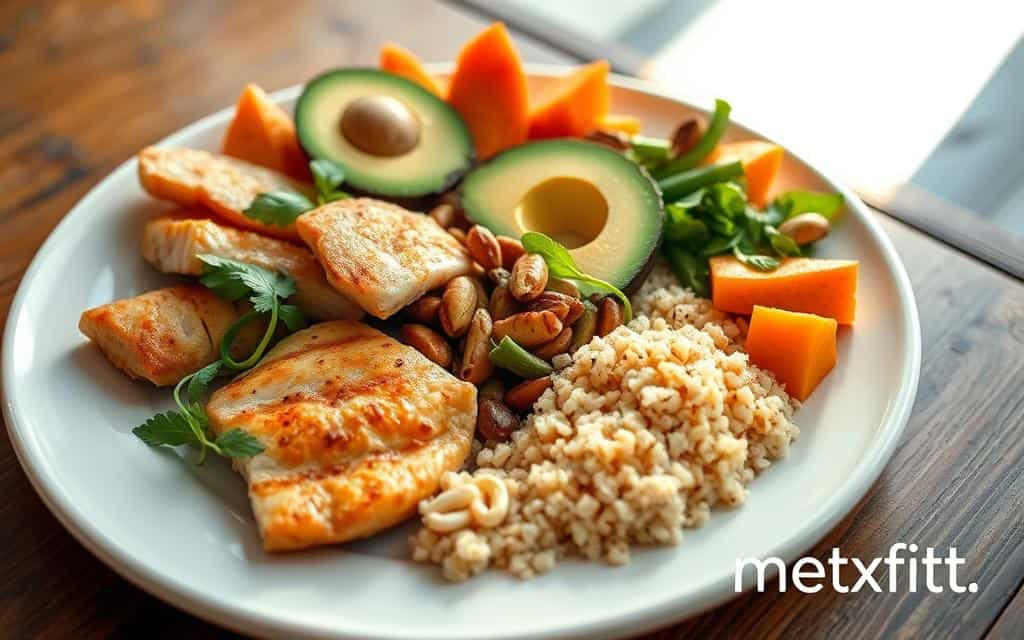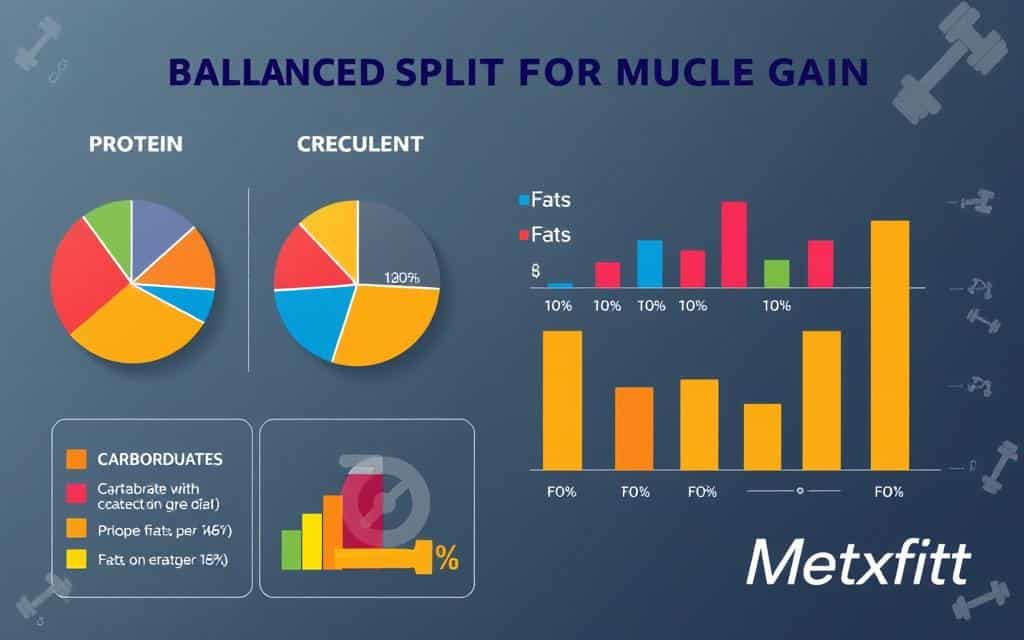Did you know bodybuilders eat 3,000 to 5,000 calories daily to grow muscle? Finding the right balance of macronutrients is key to getting the lean, muscular body you want. This post will explain the science behind the best macronutrient ratios for balancing macros for muscle gain. We’ll also share practical tips and ways to tailor your diet for muscle growth.

Key Takeaways
- Boost Your Muscle Growth with the Right Nutrition!
- Understand Macronutrients—Learn how protein, carbs, and fats help in muscle growth & recovery.
- Protein Power Discover the optimal amount of protein required for maximum muscle Please consider planning your carb intake thoughtfully to enhance performance and
- Rightly to improve performance & recovery.
- Healthy Fats Matter—Support hormone production & recovery with the right fats.
- Perfect Macro Split—Create a custom nutrition plan for your muscle-building goals.
- Expert Tips—Fine-tune your diet strategy for long-term muscle growth.
- Fuel your body the right way and build muscles effectively!
Understanding Macronutrients and Their Role in Muscle Growth
To build muscle, knowing about protein, carbs, and healthy fats is key. Each plays a big part in growing and fixing muscles. Let’s explore how they help your muscles grow and heal.
The Science Behind Protein Synthesis
Protein synthesis is the basis of muscle growth. Eating protein lets your body fix and grow muscle. It’s vital for keeping your muscles strong and lean.
How Carbs Fuel Muscle Recovery
Carbs give your body energy, especially after intense workouts. They fill up glycogen stores in your muscles. This technique helps your muscles heal and get stronger over time. Using carbs wisely can really help you build muscle.
Essential Fats for Hormone Production
Healthy fats, like those in nuts and avocados, help make important hormones. Hormones like testosterone and growth hormone are key for muscle growth and health. Eating enough healthy fats supports your bodybuilding goals and health.
| Macronutrient | Role in Muscle Growth | Best Sources |
|---|---|---|
| Protein | Provides the building blocks for muscle repair and synthesis | Lean meats, poultry, fish, eggs, dairy, legumes |
| Carbohydrates | Replenish glycogen stores and fuel muscle recovery | Whole grains, fruits, vegetables, starchy carbs |
| Healthy Fats | Support hormone production and overall health | Nuts, seeds, avocado, olive oil, fatty fish |
Knowing how each macronutrient works helps you make a diet that supports muscle growth. This diet gives your body what it needs to reach your fitness goals.
How to Balance Macros for Muscle Gain
To get the best results, finding the right macro split is key. Knowing the best ratios for muscle growth helps you eat right. This strategy supports lean muscle and helps you reach your fitness goals.
The best mix is usually 40-50% protein, 30-40% carbs, and 20-30% healthy fats. But what works for you might not work for others. Try different ratios and watch how your body reacts to find what’s best.
Start by eating more protein to help your muscles grow. Then, eat carbs to give you energy for workouts and help you recover. Don’t forget to include healthy fats in your diet for hormone regulation and overall health.
| Macronutrient | Percentage for Muscle Gain |
|---|---|
| Protein | 40-50% |
| Carbohydrates | 30-40% |
| Fats | 20-30% |
Remember, the right macro split is different for everyone. Try new things, track your progress, and adjust as needed. This way, you’ll get the most out of your muscle-building efforts.

“The key to building muscle is to consume the right macronutrient ratios that support protein synthesis, glycogen replenishment, and hormone production.”
By eating the right mix of macros, you can reach your muscle-building goals. Stay consistent, be patient, and trust the process. Your muscles will appreciate it.
Calculating Your Optimal Protein Requirements
To grow muscles, you need the right amount of protein. How much you need depends on your workouts, body type, and how fast you digest food. Knowing how protein helps muscles grow is key.
Protein Timing Throughout the Day
The timing of when you eat protein is important for building muscles. Eating protein often helps your muscles grow and recover. Try to eat a nutritious protein source every 3–4 hours.
Best Protein Sources for Muscle Building
- Lean meats (chicken, turkey, lean beef)
- Fish and seafood (salmon, tuna, shrimp)
- Dairy products (Greek yogurt, cottage cheese, milk)
- Eggs and egg whites
- Plant-based proteins (tofu, tempeh, lentils, quinoa)
Adjusting Protein Based on Training Volume
The amount of protein you need varies depending on your workouts. Aim for 0.7-1 gram of protein per pound of body weight. If you’re doing many rigorous workouts, you might need more protein.
| Training Volume | Protein Intake (per lb of body weight) |
|---|---|
| Low Volume | 0.7-0.8 g |
| Moderate Volume | 0.8-0.9 g |
| High Volume | 0.9-1.0 g |
Finding the right protein for muscle growth is a personal thing. Try different ways, watch how you do, and adjust as you go. This practice will help you reach your muscle-building goals.
Strategic Carbohydrate Planning for Maximum Gains
Carbs are key for building muscle. They fuel your workouts and help your muscles recover. Using a smart carb cycling plan can boost your muscle growth.
Carb cycling means changing how many carbs you eat each week. You eat more carbs on intense training days. This approach gives your muscles the energy they need. On easy days or rest days, you eat fewer carbs to maintain muscle growth.
Good carbs for muscle gain are complex ones like oats, brown rice, quinoa, and sweet potatoes. They give lasting energy and important nutrients for health and recovery.
Read Also: 7 Vegetarian Recipes for Weight Loss | Best Meal Plans
It’s important to eat carbs at the right times. Eating quick carbs like white rice before and during workouts helps. After, mix complex and rapid carbs to start muscle recovery.
| Carb Cycling for Muscle Growth | Heavy Training Days | Light Training/Rest Days |
|---|---|---|
| Carbohydrate Intake | Higher | Lower |
| Best Carb Sources | Oats, brown rice, sweet potatoes | Berries, leafy greens, cruciferous veggies |
| Timing | Pre-workout, intra-workout, post-workout | Spread throughout the day |
Plan your carbs smartly with your workouts. This way, your muscles get the fuel they need. Carb cycling and proper workout nutrition help you build muscle more effectively.

“Optimal carbohydrate timing and intake can make a significant difference in your ability to build and maintain muscle mass.”
Incorporating Healthy Fats Into Your Muscle-Building Diet
Building muscle is not just about protein and carbs. Healthy fats are key for muscle growth and health. Let’s see how to add the right fats to your diet.
Omega-3 to Omega-6 Balance
The omega-3 to omega-6 ratio is important for muscle recovery. Aim for a 1:1 to 1:3 ratio. Omega-3s are in fatty fish, chia seeds, and walnuts. Omega-6s are in nuts, seeds, and oils.
Fat Sources for Enhanced Recovery
Omega-3s and MCTs help with muscle recovery. Eat foods like salmon, avocado, and olive oil. They boost recovery.
Timing Fat Intake Around Workouts, it
And you eat fats that matter. Eat them before or after workouts, not during. This procedure helps your body use carbs better for exercise. Healthy fats are vital for muscle growth and health. Try different fats and times to see what works for you.
Creating Your Personalized Macro Split
Starting your muscle-building journey begins with a macro split made just for you. You’ll figure out how many calories you need and balance your protein, carbs, and fats. This way, you can make a meal plan that helps you grow lean muscle.
First, you’ll need to find out how many calories you need for muscle gain. You’ll add extra calories to your daily intake. This technique helps you grow muscle without gaining too much fat. Then, you’ll adjust how much protein, carbs, and fats you eat to fuel your muscles.
As you change your macro split, pay attention to how your body reacts. You might need to adjust your protein, carbs, or fats to get better results. Being flexible and making choices based on data will help you create a meal plan that works for you. This way, you can reach your goal of lean gains and the body you want.
🚀 Start Your Fitness Journey Now! 👉 Visit MetxFitt.com and achieve your fitness goals today!
FAQ
How do I balance macros for optimal muscle gain?
To gain muscle, focus on protein, carbs, and healthy fats. Eat more calories than you burn, aiming for 30% protein, 40% carbs, and 30% fats. Adjust these amounts based on your body and how much you train.
What is the optimal protein intake for muscle hypertrophy?
For muscle growth, eat 0.7-1 gram of protein for every pound of your body weight. Eat protein all day, especially around your workouts. This process helps build muscle.
How do I use carb cycling to support muscle growth?
Carb cycling means switching between high-carb and low-carb days. Eat 2–3 grams of carbohydrates per pound of body weight on high-carb days. On low-carb days, eat 0.5-1 gram per pound. This technique helps grow muscle without gaining too much fat.
What are the best sources of healthy fats for building muscle?
Eat healthy fats like avocados, nuts, seeds, olive oil, and fatty fish. Aim for the right balance of omega-3 to omega-6 fats. This fatty acid supports hormone production and recovery. Eat fats around your workouts for best muscle growth.
How do I create a personalized macro split for muscle gain?
To begin, please determine the number of calories required for muscle gain. Then, adjust your macros to 30% protein, 40% carbs, and 30% fats. Based on your body and training, tweak these ratios to see what works best for you.

Fitness Coach | Fat Loss Expert | Nutritionist
Online Fitness Trainer – Custom workouts for fat loss, muscle gain & home fitness.
Certified Nutritionist (NASM) – Smart diet plans for faster results.
Transformation Specialist – Proven programs to reshape your body & health.



gohtvuyluthqywvmpjfydyiwztslne